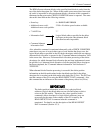
Command Specifications
232 C141-C013
− Cautions in specifying the D list
The P List, containing defect position information, is always recorded on
the HDD when it is shipped from the factory. Also, information on defect
positions for which alternate block processing has been implemented
during operation is recorded as the G List. The function which specifies
defect position information as the D List when the FORMAT UNIT
command is executed, is prepared mainly to specify initial defect position
information of the disk media which does not have the P List recorded on
it. In the HDD, by specifying use of the P List and G List, advance notice
of the defect positions can be specified during initialization, so ordinarily,
it is not necessary to use the D List. When the D List is used for the HDD,
caution should be exercised in the follow points.
1. The maximum number of defective sectors (total amount of 'sector
slip' and 'alternate sectors') are calculated per :
a) Current condition of reallocated sectors:
(how many Slip Sectors have been allocated ? and so Alternate
Sectors ? Since Defect table entry for Slip and Alternate are
different size.)
b) The maximum size of Defect Management Table (Fixed value)
c) Current allocation condition of 'sector slip'
(i.e. Up to 16 consecutive Slip Sector can be controlled by 1 Slip
Defect entry. So the necessary table size are varied not only the
number of Defects but also the number of consecutive Slips.)
Consequently, the concrete Defect numbers cannot be described
though the HDD guarantees 12,000 Slip Sectors and 3,000 Alternate
Sectors at minimum. If defect processing which exceeds this limit is
specified in the FORMAT UNIT command, that command is
terminated with a CHECK CONDITION status (HARDWARE
ERROR [=4] / No defect spare location available [=32-00]).
2. A defect descriptor specified as the D List are received normally if
the specified defect position information is within a range which
does not exceed the disk drive's physical boundaries (User Space),
and is recorded as the G List, but formatting processing is executed
only for the User Space in the range specified in the "Block
descriptor" and "Format parameters" (Page 3), and the "Drive
parameters" (Page 4) of the MODE SELECT parameter.
3. If a defect descriptor in the "Byte distance from the Index format" is
specified in the D List, depending on the byte position of the
specified defective byte, 2 sectors may be processed as defective
sectors with one defect descriptor, or 1 sector may be processed as a
defective sector with 2 or more defect descriptors. Also, if the
specified defective byte position has no influence on data block
read/write operations, that defect position information is disregarded
and is not the object of defective sector processing, and thus is not
recorded in the G List. Therefore, the defect position information
specified in this command may not necessarily coincide with the
defect position information read with the READ DEFECT DATA
command after this command is terminated.


















